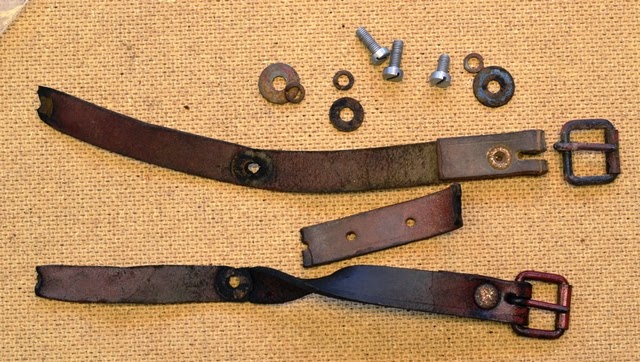Continuing with updates on progress being made with the interior, body, engine, and "little jobs" that will eventually produce a restored Alfatross, here are the last two states of separation: New Mexico and Arizona.
New Mexico
I'm still grinding along here in Santa Fe with the "little jobs." Compared with modern cars the electrical components of The Alfatross are Stone Age technology. I've checked out most of the relays, switches and lights, but then I encountered the
"Trafficator." I'm talking about the little box under the dash crammed with the kind of electrical components that Thomas Edison would have immediately recognized. It tells the lights when to act like turn signals, parking lights, or brake lights.
 |
| The Alfatross' Trafficator box, made by Carello. Disarmingly simple-looking on the outside . . . . |
 |
| . . . but a little more complicated inside. |
When I opened up the Trafficator box I expected to see the contents all in good order, as they were in the other relays and switches. But no such luck! Two obvious problems jumped out at me: an electrical connection was broken and a contact arm on one of the solenoids was bent away from its intended point of contact, rendering it useless.
 |
| I'm sure this schematic of the trafficator will be helpful when I'm connecting it to the wiring harness, but it doesn't tell me where to attach the loose end of that fine coil of wire! |
Arizona
DeWayne and Roger, the engine guys, seem to be satisfied with the replacement Crower cams ("way less money than the Italians and way faster delivery, plus I prefer their profile design with USA gasoline vs Italian design on EU gas"). So that issue is finally resolved.
With the block, exhaust valves, crank, head, and chain box components done they have now turned their attention to the carbs, oil lines, distributor, oil pump assembly, oil pan, water pump, block inspection ports and plating and metal finishing.
One of the carbs had a broken shaft return spring, necessitating drilling out the frozen throttle plate screws, to replace the spring. One accelerator pump cover was found to be cracked throughout and its activation lever bent, so it will need replacement.
 |
| Drilling out the throttle butterflies and re-tapping them. DeWayne Samuels. |
 |
| The original Solex 40 P II carbs after cleaning. DeWayne Samuels. |
 |
| The venturies and throttle shaft. DeWayne Samuels. |
 |
| The cleaned and prepped Solex 40 PII carbs, awaiting reassembly. DeWayne Samuels. |
Profiling the piston valve relief area is under way. When this is finished they will perform a static balance prior to a dynamic balance of the whole assembly.
One of the last hurdles is valve springs. DeWayne says he and Roger are having a serious problem sourcing replacement valve springs. They decided to rework the spring seat area in the cylinder head to allow 0.150” additional height in the spring package, making the spring development more feasible, but are still unhappy with the options. So far the Italian sources they have queried are not sure they can come up with stock pressure springs, but DeWayne and Roger think that the stock springs are too weak anyway. They found some Ferrari inner springs with a spacer but the spring rate pressure is off - which is as important or more so than the seat pressure. The search continues . . . .So that's the overall update for The Alfatross in its present four states of separation.















